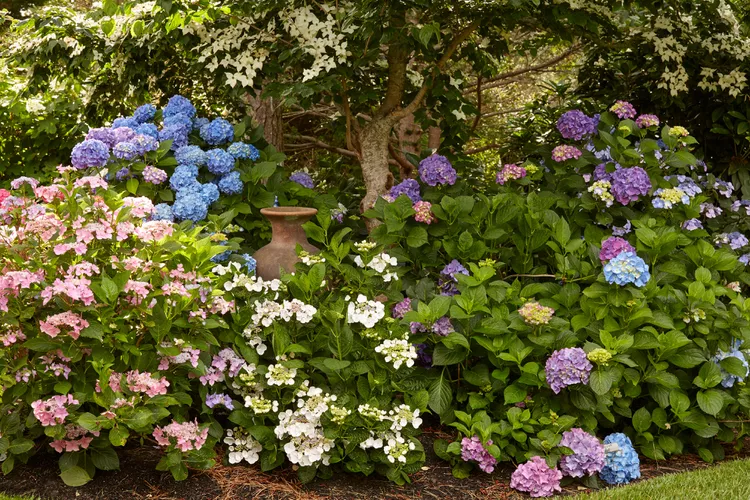Thanks to plant breeding, scores of hydrangea varieties are available in garden centers. But when do hydrangeas bloom, so you'll know when to expect the showy flowers in your garden? These popular shrubs vary by size, color, hardiness, and yes, bloom time.
Are you looking for a jolt of color in late spring? There’s a hydrangea for that. Maybe you need structure and flowers in early fall? There’s a hydrangea for that, too. Add a few different types of these easy-going shrubs to your landscape and you can enjoy a profusion of long-lasting flowers almost year-round. This seasonal guide will help you figure out when the different types of hydrangeas bloom.
Spring-Blooming Hydrangeas
Count on bigleaf and oakleaf hydrangeas in warm regions to begin blooming in late spring. Camellias, rhododendrons, azaleas, lilacs, and many other woody plants provide flower power in the early days of spring when these hydrangea plants are just beginning to send up new leaves and shoots. In gardening regions with cold, snowy winter weather, hydrangeas often don’t begin flowering until summer, but if you garden in USDA Zones 7–11, grow these hydrangeas for flowers in spring.
Bigleaf Hydrangea
Bigleaf hydrangea (Hydrangea macrophylla) has large, showy flowers in shades of pink or blue. Bigleaf varieties are some of the most tender hydrangea shrubs. Expect them to begin blooming in late spring. They bloom earlier than other types of hydrangeas because they form their flower buds the previous year. The tender flower buds overwinter—provided winter temperatures don’t dip too low—and flowers open several weeks earlier than the ever-popular panicle hydrangea varieties.
Reblooming hydrangeas are part of the bigleaf group, but many of the reblooming types don’t unfurl a sizeable flush of flowers until summer.
Growing notes: Bigleaf hydrangeas grow best in well-drained soil and part shade. Afternoon shade is essential in areas with hot summers. Cool, moist soil is also necessary for vigorous growth and large, full blooms. Plant bigleaf hydrangeas at the edge of a woodland or on the north or east side of a building to protect them from harsh sunlight. They are hardy in Zones 6–9.
Oakleaf Hydrangea
Oakleaf hydrangea (Hydrangea quercifolia) is a North American native that thrives in shade and has eye-catching lobed leaves resembling those of an oak. This large shrub’s cone-shaped flowers debut soft green in mid- to late spring, turn creamy white, and fade to rose or pink by mid-summer. In Zones 5 and 6, oakleaf hydrangea begins flowering in early summer.
Growing notes: Plant oakleaf hydrangea in cool, moist soil and part to full shade. Some varieties can tolerate more sun than others. Deer are especially fond of oakleaf hydrangea; don’t plant in areas with a high deer population. They are hardy in Zones 5–9.
Summer-Blooming Hydrangeas
Summer is prime time for many hydrangeas. Spring-blooming varieties often continue blooming through summer, or their resplendent flowers take on new tones as they age. Hydrangeas’ long-lasting blossoms translate to flowering windows that span several weeks to more than three months.
Reblooming bigleaf hydrangeas, for example, begin blooming in early summer and continue flowering sporadically until the first frost. Plant the following summer-flowering hydrangeas to enjoy armloads of flowers in July and August.
Panicle Hydrangea
Panicle hydrangeas (Hydrangea paniculata) are some of the most popular flowering shrubs. They bloom in early summer, and their sturdy, long-lasting blooms often fade from one color to another as the season progresses. For example, ‘Little Quick Fire’ flowers (shown here) open white and then turn blush pink, bright pink, and finish red near the end of summer.
Growing notes: Plant a panicle hydrangea where it will receive morning sun and afternoon shade in Zones 7 and 8. In Zones 3 to 6, it can tolerate full sun. Moist, well-drained soil is best. They are hardy in Zones 3–8.
Reblooming Hydrangea
Reblooming hydrangeas (Hydrangea macrophylla) are specially selected bigleaf hydrangea cultivars that bloom on new stems produced during the growing season. Traditional bigleaf hydrangeas bloom on stems produced the previous year. Reblooming hydrangeas must be thriving to unfurl new blooms every couple of weeks from early summer until frost. Fertilizer encourages good growth.
Growing notes: Plant reblooming hydrangeas in part shade or full sun and well-drained soil. Apply a granular fertilizer around Endless Summer and other reblooming varieties when the ground thaws in spring and again in late spring. Water regularly to encourage vigorous growth. They are hardy in Zones 5–9.
Smooth Hydrangea
Loose, delicate flower heads give smooth hydrangea (Hydrangea arborescens) an informal appearance. The flowers are green initially, then turn white, and finally become light brown. One of the most well-known varieties of smooth hydrangea is 'Annabelle,' shown here. Give plants room to spread, and they will create a drift of flowers and foliage.
Growing notes: Plant in part to full shade and well-drained soil. Smooth hydrangeas spread by underground stems to slowly form a colony. Prune spent flowers in early summer, and the plant will rebloom in fall. They are hardy in Zones 3–9.
Fall-Blooming Hydrangeas
Both reblooming and smooth hydrangeas open new flowers until the first fall frost. Dry conditions and summer heat can slow the growth of these hardworking plants. Spur them to continue blooming by watering deeply once a week when rain isn’t consistent. Resist the urge to fertilize. Applying fertilizer to hydrangeas in late summer can produce tender new growth that is susceptible to winter injury.
A Word About Winter
Panicle and oakleaf hydrangeas don’t unfurl new flowers in fall and winter, but their flower power continues. Summertime flowers change color as the seasons progress, eventually turning beige in late fall. The bold, long-lasting flower heads stand strong through wind, snow, and ice to decorate the landscape until the following spring.




















